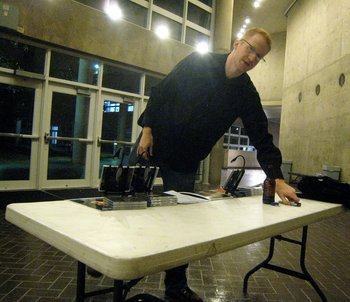 What fascinates me about comedian Steve Hofstetter — other than being a funny, wickedly intelligent comic — is that he’s doing the same thing as Radiohead, Trent Reznor, and Nine Inch Nails. And yet Hofstetter is not a household name.
What fascinates me about comedian Steve Hofstetter — other than being a funny, wickedly intelligent comic — is that he’s doing the same thing as Radiohead, Trent Reznor, and Nine Inch Nails. And yet Hofstetter is not a household name.
Like Radiohead and Nine Inch Nails, Hofstetter has released his latest CD, “The Dark Side of the Room,” on his Website and has asked fans to pay whatever they want — 1 cent (I wish it were free!) to $4.95 (a bargain!) to $8.95 (save a buck!) to $29.95 (big tipper!), and everything in between.
Ever since I first posted on Hofstetter for last100 in December, I’ve noticed that artists are more often releasing their work on the Internet for free or with various payment schemes. This side-stepping-the-record-label approach is all the rage — and clearly a new business model.
We know Radiohead’s story. And Reznor’s work with Saul Williams. And the recent release from Nine Inch Nails, Reznor’s band.
But there’s also singer-songwriter Jill Sobule, who asked fans to help raise $75,000 for “Jill’s Next Album” — a goal she surpassed in 53 days. Instead of asking fans to donate whatever they wanted, Sobule set up levels from $10 (unpolished rock) to $10,000 (weapons-grade plutonium). More than 500 people in 44 states and 11 countries contributed.
There’s classical violinist Tasmin Little, who released her most recent project, “The Naked Violin”, for free on her Website with a three-step challenge: listen to the music, tell her what you thought of it, and go to a concert or buy one of her other CDs. Since the music’s release in January, Little’s site has recorded more than 250,000 hits and 3 terabytes of content has been downloaded.
The list goes on.
Radiohead, Reznor, and Nine Inch Nails are star performers with household names. Sobule and Little are established artists in their own right who have released several CDs each, have had recording contracts, and who’ve built a fan base over the years.
But what about Steve Hofstetter? Can this model work for him?
The Numbers Say Yes
 Hofstetter is a lanky, bespectacled red-head who is an up-and-coming comedian with a strong Internet following among high school and college-age kids. He’s also an accomplished writer, having authored several humor books and columns for SportsIllustrated.com, NHL.com, ESPN Magazine, and Maxim.
Hofstetter is a lanky, bespectacled red-head who is an up-and-coming comedian with a strong Internet following among high school and college-age kids. He’s also an accomplished writer, having authored several humor books and columns for SportsIllustrated.com, NHL.com, ESPN Magazine, and Maxim.
Hofstetter’s last CD, “Cure for the Cable Guy,” was his first official release, and it reached No. 20 on the Billboard comedy charts. The success of “Cable Guy” landed Hofstetter appearances on VH1, Showtime, ESPN, and others, and he’s at the max of allowed friends on MySpace and Facebook.
Hofstetter received a $15,000 advance for “Cure for the Cable Guy.” While it has sold relatively well, it has not reached $30,000 in sales, the point at which Hofstetter’s royalty kicks in and he makes additional money. In other words, he most likely will not make another penny from the record label.
To make matters worse, Hofstetter said he made about $1.50 for every CD sold, assuming an average price of about $15. He made less on iTunes — about 60 to 75 cents (of a full $9.95 download) — but at least on iTunes he received some prime placement and notice on the store’s featured lists, which helped boost sales.
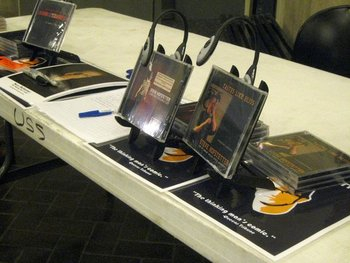 “In order to break even,” Hofstetter said before a recent show at Texas Christian University, “I have to sell between 20,000 and 25,000 copies and that is without counting my in-person sales. So that is, for a comedy album, from someone who is not a household name, unheard of. That just doesn’t happen.”
“In order to break even,” Hofstetter said before a recent show at Texas Christian University, “I have to sell between 20,000 and 25,000 copies and that is without counting my in-person sales. So that is, for a comedy album, from someone who is not a household name, unheard of. That just doesn’t happen.”
As he was working on his next release, a girl friend (now ex-girl friend) showed him an article in Billboard on Radiohead’s “In Rainbows” experiment. The timing couldn’t have been better as Hofstetter quickly decided it was how he wanted to release “The Dark Side of the Room.”
“I wouldn’t have thought of this on my own,” Hofstetter said. “The second I saw what they were doing, the light bulb went off. Wow, that’s a cool idea.”
Hofstetter’s chief concern was selling “The Dark Side of the Room” on the Web and at his shows. He didn’t want fans to be pissed off when the $15 CD they bought at a concert could have been purchased for half the price (or less) on the Internet.
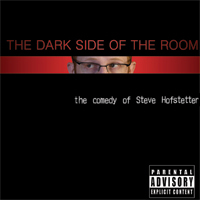
As it turned out, Internet sales boomed and haven’t hurt sales of the CD at his shows. In fact, many fans have told him they’ve bought the digital download (at a reduced price) and the CD at one of his performances. (Like Radiohead, Hofstetter will be releasing “The Dark Side of the Room” on a CD soon for sale in stores and as a digital download at iTunes.)
All of which adds up to more money in Hofstetter’s pocket. Because he paid for much of the production of the CD up front — engineering costs, graphic design, digital distribution preparation — he keeps every penny paid by fans.
Remarkably, in nearly three months since its release, “The Dark Side of the Room” has averaged about $5.80 a download — triple what he would have received under the terms of his last record deal.
And while he has not reached the $15,000 advance he received for “Cure for the Cable Guy”, Hofstetter expects to surpass that mark this year and for “Dark Side” to continue earning money for years to come.
“It’s fantastic,” Hofstetter said. “I am making more on this album than on any other album I’ve done. More people are seeing my stuff.
“It’s incredible. It’s amazing the difference in profit margin. It’s so cool. The fans pay less and the artists make more. It’s the greatest thing.”
So the answer is, yes, this model can work for artists like Steve Hofstetter.
Why is that?
How to Successfully Release Your Own CD on the Web
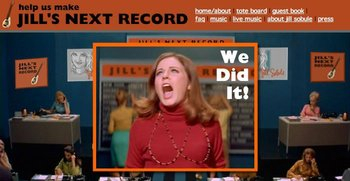 Radiohead, Reznor, Nine Inch Nails, Sobule, Little, and many others already have existing fan bases, and they tap into these for support. What about an up-and-comer like Hofstetter, who is still establishing himself?
Radiohead, Reznor, Nine Inch Nails, Sobule, Little, and many others already have existing fan bases, and they tap into these for support. What about an up-and-comer like Hofstetter, who is still establishing himself?
As it turns out, Hofstetter is doing what these artists are already doing, although not nearly as well. Even so, he’s learning, taking notes, and making adjustments.
For one, content is always king. Put crap on the Internet, Hofstetter says, you’re fans will know it and won’t buy it.
 For another, differentiate your offerings and create something special for every item sold, something that Radiohead and Reznor have mastered. Radiohead’s higher-priced “In Rainbows” offering included a second CD, among other fun things, that wasn’t available at the pay-what-you-want level. The physical CD sold at Best Buy was missing additional cuts but featured collectable stickers and a booklet.
For another, differentiate your offerings and create something special for every item sold, something that Radiohead and Reznor have mastered. Radiohead’s higher-priced “In Rainbows” offering included a second CD, among other fun things, that wasn’t available at the pay-what-you-want level. The physical CD sold at Best Buy was missing additional cuts but featured collectable stickers and a booklet.
In today’s digital world, everything an artist does — out-takes and works in progress, bootleg recordings, t-shirt designs, photographs, whatever — will be of value to some fans.
Finally, Hofstetter and the others are doing exactly what founding Wired executive editor Kevin Kelly wrote about recently on his blog The Technium: finding 1,000 True Fans. Kelly notes that the so-called long tail is good for two classes of people: the aggregators such as Amazon and Netflix and 6 billion consumers. The tail, he says, is a “decidedly mixed blessing for creators.”
“Individual artists, producers, inventors and makers are overlooked in the equation,” Kelly writes. “The long tail does not raise the sales of creators much, but it does add massive competition and endless downward pressure on prices. Unless artists become a large aggregator of other artist’s works, the long tail offers no path out of the quiet doldrums of miniscule sales.
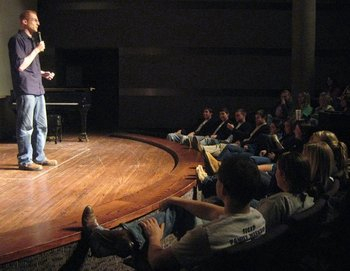
“Other than aim for a blockbuster hit, what can an artist do to escape the long tail?”
Kelly’s suggestion is to find 1,000 True Fans — a semi arbitrary number, but you get the idea. Reach the fans who care about you and will purchase everything you produce. They’ll go to every show when you’re in town, buy the t-shirts, hats, and coffee mugs, purchase the digital download and the special edition boxed set, and who can’t wait for your next offering.
Find 1,000 True Fans, get them to spend $100 a year to support your work, and you’ve got an income of $100,000 a year, minus modest expenses, doing what you love doing.
And how is this accomplished? Radiohead, Nine Inch Nails, Sobule, Little, and other established artists have spent years cultivating a fan base independent of their record labels. Hofstetter is doing the same thing, only he has to work harder as he’s just starting out, relatively speaking.
Hofstetter may be the first true comedian of the digital age. He uses the technology available to him, not unlike Radiohead and Nine Inch Nails: low-cost, professional-level production tools, a broadband connection, the Internet, a Website, cross-linking with other comic sites, a blog, Web commerce, artistic diversity (standup comedy, humor writing, radio and TV development), leveraging social media sites such as YouTube, and using social networking sites like MySpace and Facebook.
“The fact is, with the exception of the biggest acts out there, you don’t sell thousands of records a week, you don’t play venues that can seat more than a few thousand people,” Hofstetter said. “Even the guys who are doing great are playing 2,000, 4,000-seat venues, not Madison Square Garden.
“All you need is 2,000 people and you’re set for life.”
